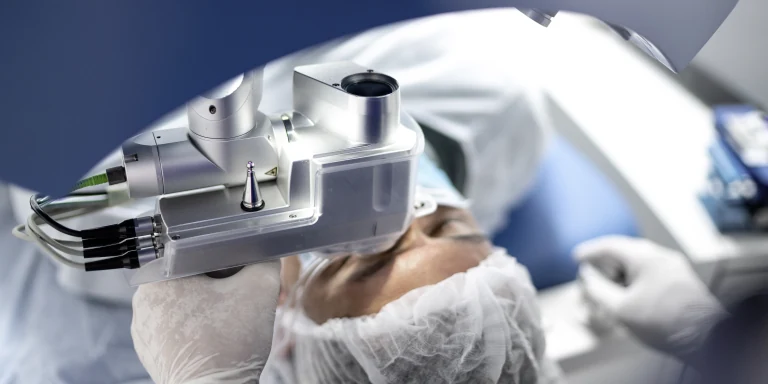Laser eye surgery – a safe bet?
Enjoying good vision without any visual aids is a tempting concept for many of us and the dream is made possible with refractive laser eye surgery. But at what cost? And what exactly happens during treatment?

Glasses are currently in fashion. But they can often cause some inconvenience: they fog up, break or just get lost. When the sun comes out, you have to swap them for a pair of sunglasses – or during sport, for sports glasses. What’s more, a lot of people feel more attractive without them. Fashion or not.
Even contact lenses can be troublesome: they can get lost, dry out the eyes, are expensive and need regular care. And some people’s eyes just aren’t compatible with contact lenses.
It’s no wonder that those with less-than-perfect vision often toy with the idea of having laser eye surgery.
Helsana’s contribution towards the costs
COMPLETA PLUS supplementary insurance covers 100% of the costs for corrective laser eye surgery, up to CHF 500 per eye and per calendar year. This also applies for laser procedures carried out abroad.
Eye laser technology then and now
In 1989, refractive corneal corrective treatment using an excimer laser (Lasik) was performed for the first time in Berlin. In the thirty years since, not only has the refractive laser technology undergone strong development, but specialist expertise has become more evolved. Laser eye surgery is now one of the most common voluntary treatments performed in the world. Nowadays, any serious complications – such as permanently reduced vision – can practically be ruled out. The market features numerous providers who work with tested and certified methods and have state-of-the-art laser and lens technology at their disposal. All kinds of vision problems can be corrected: corneal deformation, short-sightedness and long-sightedness. Even “age-related” long-sightedness can be corrected as part of a special procedure.
Which conditions need to be met to be eligible for laser eye surgery?
- The eyes have to be healthy (no viral diseases, inflammations, etc.).
- The eyes must have completely developed. This is the case between the ages of 20 and 25. The vision problem must not have changed in the two years prior to surgery. Once the eye is fully developed, age no longer plays such a significant role in laser eye treatment. Corrective laser surgery for cosmetic and practical reasons is usually performed between the ages of 20 and 45.
- The cornea of the eyes has to be thick enough and must not feature any abnormalities.
- The dioptre values must lie within a certain range. In general, dioptres of -12 to +6 can be corrected using laser treatment. Different limits apply for short-sightedness, long-sightedness, presbyopia and cornea deformation and determine whether laser treatment can actually be carried out and if so, using which method.
- Laser eye surgery is not permitted during pregnancy. Pregnancy hormones alter the tissue and as a result, can also have an impact on vision.
- This kind of surgery is also unsuitable for people suffering from rheumatism or diabetes.
Can you have laser eye surgery for presbyopia?
From the age of around 45, age-related long-sightedness, or presbyopia, sets in for many people: time for reading glasses. In certain cases it can be corrected with laser surgery. Once you reach 45, your ability to see things clearly close up or from a distance declines, as the body’s lenses lose their ability to adapt. If laser treatment is not an option, artificial lenses can be surgically inserted. It is best to ask your ophthalmologist whether surgery is a viable option for you. Helsana does not reimburse laser eye treatment for correcting presbyopia.
The most common laser eye surgery treatment types
All laser eye surgery treatments involve treating different layers of the cornea using a laser. The procedures fall into two categories: in-depth or surface-deep. A range of different factors come into play when deciding which treatment type is best:
- physiological requirements (e.g. manifestation of visual impairment, thickness of cornea, severity of cornea deformation)
- features of the respective treatment type (e.g. duration of treatment, duration until full vision is regained, risks, recovery time, severity of pain)
The laser eye surgery treatment type worth considering therefore depends not only on physical conditions, but also personal preferences. In the jungle of the many available treatments, it is very easy to get lost.
TransPRK is considered the most modern and fastest eye laser treatment type that exists. It is performed in a single step without touching the eye. The actual surgery takes just a few seconds per eye, with the cornea lasered directly. The benefit: no corneal flaps can become loose or move. The wound-healing process is quick and usually takes just three days. Full vision is regained after several weeks. This laser operation is mainly suitable for patients with short-sightedness or corneal deformation. It can also be performed on thinner corneas. In the case of long-sightedness, only low dioptres can be corrected. The risk of reactions (e.g. scarring) during wound healing and the rate of infection lie slightly above those of older treatment types.
This is the most well-known and most frequently performed refractive laser surgery. As with the Lasik method, it involves slicing part of a corneal flap and folding it over using a Femto laser. This process takes around 30 seconds. A second laser (excimer) corrects the vision problem on the underlying corneal tissue. The flap is then closed again. The procedure takes around 10 minutes per eye. Unlike the Lasik treatment (keratome) involving a blade, the special Femto laser is used here, which stands for maximum precision. Not only is the surgical procedure quick, but the healing process is also usually guaranteed to be fast. Owing to the flap, however, there is a slightly elevated risk of complications such as dry eyes. This treatment type is suitable for severe short- or long-sightedness, and requires the cornea to have a sufficient thickness.
During this traditional surgical method, part of a corneal flap in the eye is sliced open and folded over using the keratome. A second laser corrects the vision problem on the underlying corneal tissue. The flap is then closed again. The operation takes approximately 10 minutes per eye. The benefits of this method are its rapid, post-operative rehabilitation, with those treated generally experiencing good vision after just one day. They also report a lower level of pain than with the predecessor PRK method. However, the flap does create an elevated risk of complications and the method is not suitable for patients whose cornea is too thin or too irregular.
PRK is the older standard method of laser eye surgery. It is an ideal alternative to the Lasik surgery if this is not an option because of a low level of long-sightedness or a thin cornea. The procedure takes several minutes per eye. During the PRK surgery, the uppermost corneal layer (epithelia) is removed manually. The laser correction is then carried out, with a protective lens being inserted for wound healing. The benefit: no cutting is involved, meaning there is no risk of any cut corneal flap becoming displaced. The procedure has also been performed since 1988 and is therefore tried and tested. However, the mechanical scraping of the cornea can cause a lot more pain, while the risk of infection is greater and the wound-healing process takes longer than with newer procedures such as TransPRK or Femto Lasik.
This procedure is an evolved variant of the PRK treatment type and an alternative to the Lasik surgery – if the latter is not an option. For example, it is appropriate for treating patients with severe short-sightedness, a thin cornea or corneal scars. The surface-deep procedure only involves removing the uppermost conjunctiva layer using an alcohol-based solution and moving it to the side. The eye laser performs the actual correction on the exposed corneal surface. The moved conjunctiva is then placed back over the lasered zone. The result: less pain than with PRK, but more than with Lasik and TransPRK. Unlike other treatments, it therefore does not involve any cutting. While the healing process is shorter than with PRK, it takes longer than with the Lasik and TransPRK procedures. It also takes several weeks for the desired vision to be achieved.
This variant is a modern variant of PRK and poses fewer risks than Lasik surgery. During Epi-Lasik treatment, the flap is also lifted and folded over before being returned after lasering. Owing to the special technique, however, there is a risk of a miscut that cannot be corrected, which is why this method tends to be discouraged.
The ICL is an ideal procedure for anyone unable or unwilling to undergo laser treatment. The first step of this operation involves cutting open the cornea. An intraocular contact lens is then placed on top of the natural lens. The operation takes around 20 to 30 minutes per eye. The benefits include rapid recovery, a lack of dry eyes and the option to even reverse the correction in an emergency. It can also be performed on thin corneas. Risks include infections, light rings around light sources (halos), increased eye pressure, increased glare at night or damage to the eye lens, which can result in premature cataracts. The surgeon performing the procedure has to be specially trained and have manual dexterity.
Consult your eye specialist for a more precise explanation of the different treatment types and choose the right procedure together.
What happens during laser eye treatment?
The laser treatment process is usually quite simple. With all types of treatment, the actual surgical procedure is very quick and is performed as an outpatient service.
- Initial consultation: a specialist will explain the advantages and disadvantages of the different types of laser surgery to you and check whether your vision problem is generally suitable for the treatment.
- Main examination: following an in-depth examination, you and your doctor will choose the best treatment type for you. You will receive all the information you need.
- Operation: the actual surgery takes just a few seconds or minutes. You should expect around an hour for the entire treatment – including preparation and follow-up.
- Recovery phase: this takes a few days depending on the treatment type
- Follow-up checks: there are usually three follow-up checks – after the first day, after around one week and after around three months. It is important that you keep these appointments. If any complaints arise in between, you must have these clarified immediately.
Risks and pain
Our eyes are a precious commodity. This fundamental truth is especially important when considering laser surgery: what happens if the surgery is unsuccessful? Is your eyesight at risk? Nowadays, major technological advances and experiences have made serious complications a very rare occurrence. However, the risks and side effects should still be taken into account when making a decision.
Most side effects such as cataracts, dry eyes or sensitivity to light are only temporary and are easy to treat with eye drops. In rare cases, the laser procedure may need to be repeated. Visual defects can also reappear after a few years, as our eyes can constantly change.
The pain depends on the respective treatment type and the individual’s perception of pain. Prior to surgery, the eye is numbed, meaning that during the procedure, you will usually only feel a slight pressure, depending on the method used. If the effect of the medication wears off, you may experience a foreign body sensation or pain. Both of these usually go away after a few hours or days.
What are the benefits of overseas offers?
In Germany, for example, or Turkey, more and more highly professional laser eye surgery centres are cropping up, offering laser eye treatments at a lower cost than in Switzerland. However, when considering treatment abroad, you should take the time and costs for research, the journey and accommodation into account. You should also consider the fact that regular follow-up checks abroad can be difficult – especially in the event of any complications. What’s more, the price differential between centres abroad and Swiss providers has significantly declined in recent years. You should therefore think carefully before choosing a tempting offer overseas.
Conclusion
Eye laser technology has seen vast progress in the past few decades. Laser surgery has now become a routine procedure. However, as with all surgery, it does come with pain and risks.
Sight is our most important sense. That’s why: if you are seriously considering undergoing laser eye surgery, make sure that you are well informed and consult with a specialist. Performing research on the internet is not a substitute for a medical consultation. And in any case, take plenty of time before making a decision.
Articles about this topic
Do you have questions?
We're here to help.


